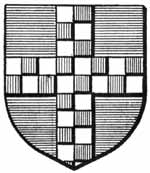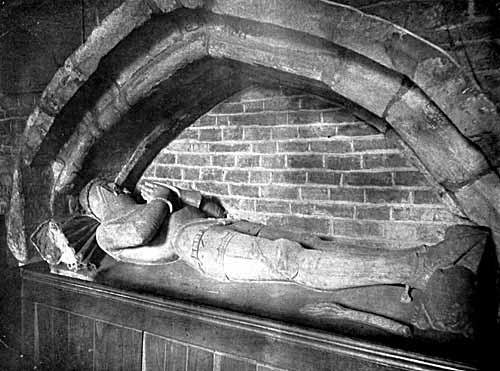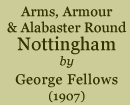< Hoveringham | Contents | Radcliffe-on-Soar >
St. Patrick's, Nuthall.
 |
ARMS OF COKEFIELD—Azure, a cross counter-company argent and gules. |
THE family of Cokefield flourished in the time of King John, in whose reign a member of the Patricius family conveyed part of the Manor of Nuthall to Robert Cokefield. They were people of position and influence until 1453, when Johannes Cokefield, miles, who had married a daughter of the Foljambe family, died without male issue. In 1462, Dame Margaret Cokefield left instructions that she should be buried in the Chapel of St. Mary within the Church of St. Patrick, against Sir John Cokefield, her late husband.
The name of Cokefield appears several times in the Records of the Borough of Nottingham. In 1356, one of the family gives a release to the Burgesses, which commences: "To all the faithful in Christ seeing or hearing this present writing,
Robert de Cockfield, Knight, greeting in the Lord......." As early as the year 1297 there was an extensive muster in Nottingham, for military purposes, of those who held land of sufficient value to make them liable to serve, and among them is the name of Johannes de Cokefield, together with representatives of most of the families referred to in this book. There is no place named Cockfield in Nottinghamshire, so the family may have originally come from elsewhere, possibly from Cokefield in Durham or Suffolk.
 |
Tomb of Sir Robert Cokefield (1360), Nuthall church. |
The effigy in Nuthall (or, as now commonly spelt, Nuttall) Church is
said to represent Sir Robert Cokefield, a Knight of the Shire in 1389
and 1392, the father of John, who was the last of the family. There is
no inscription on the tomb, but the pointed bascinet, the camail and
horizontal hipbelt, all indicate the effigy to be that of a Knight of
the period when Sir Robert lived. Round the brows are a wreath and letters ![]() and on the helm stands the family crest, namely, out of a ducal coronet,
a lion's jambe erect proper. The effigy is in a very fair state of preservation
considering its age. The arched recess was probably its original resting-place:
it has, however, had to be cut away to admit the pointed top of the bascinet,
and is rather an uncouth piece of workmanship, compared with the delicate
execution of the figure beneath it. Dr. Thoroton makes no mention of
this tomb in his history.
and on the helm stands the family crest, namely, out of a ducal coronet,
a lion's jambe erect proper. The effigy is in a very fair state of preservation
considering its age. The arched recess was probably its original resting-place:
it has, however, had to be cut away to admit the pointed top of the bascinet,
and is rather an uncouth piece of workmanship, compared with the delicate
execution of the figure beneath it. Dr. Thoroton makes no mention of
this tomb in his history.
The family name disappeared from Nottinghamshire more than three centuries ago, and their property eventually passed by marriage to the Ayscough family.
![]()
< Hoveringham | Contents | Radcliffe-on-Soar >
